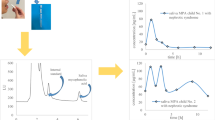Abstract
Salivary bacteria produce the enzyme lysine decarboxylase which converts lysine to cadaverine. In the absence of appropriate oral hygiene, overgrowth of these bacteria depletes lysine. This may contribute to gingival inflammation, while cadaverine contributes to oral malodor. A selective and sensitive capillary electrophoresis method with laser-induced fluorescence detection has been developed for the determination of cadaverine and lysine in saliva, as an indicator of lysine decarboxylase enzyme activity. The diamino compounds were separated in acidic background electrolyte in their mono-labeled form after derivatization with 4-fluoro-7-nitrobenz-2-oxa-1,3-diazole (NBD-F). Linearity and reproducibility of the method in the range 1–50 μmol L−1 have been demonstrated using saliva samples. The method was applied for the measurement of cadaverine and lysine in the saliva of healthy volunteers with or without proper oral hygiene. In the absence of oral hygiene, the mol fraction of cadaverine to cadaverine plus lysine in saliva increased significantly (0.65 ± 0.13 vs. 0.39 ± 0.18, P < 0.001), indicating the presence of higher amount of bacterial lysine decarboxylase, that may contribute to periodontal diseases.




Similar content being viewed by others
References
Papapanou PN (1996) Ann Periodontol 1:1–36
Levine M, Progulske-Fox A, Denslow ND, Farmerie WG, Smith DM, Swearingen WT, Miller FC, Liang Z, Roe BA, Pan HQ (2001) Microb Pathog 30:79–192
Li J, Helmerhorst EJ, Leone CW, Troxler RF, Yaskell T, Haffajee AD, Socransky SS, Oppenheim FG (2004) J Appl Microbiol 97:1311–1318
Goldberg S, Kozlovsky A, Gordon D, Gelertner I, Sintov A, Rosenberg M (1994) J Dent Res 73:1168–1172
Rosenberg M, Kozlovsky A, Gelernter I, Cherniak O, Gabbay J, Baht R, Eli I (1995) J Dent Res 74:1577–1582
Leistner E, Spenser ID (1973) J Am Chem Soc 95:4715–4725
Phan APH, Ngo TT, Lenhoff M (1982) Anal Biochem 120:193–197
Hamana K, Nakata K (2000) Microbios 103:43–51
Hanczko R, Kőrös Á, Tóth F, Molnár-Perl I (2005) J Chromatogr A 1087:210–222
Kőrös Á, Hanczko R, Jámbor A, Quian Y, Perl A, Molnár-Perl I (2007) J Chromatogr A 1149:46–55
Ohkura Y, Kai M, Nohta H (1994) J Chromatogr B 659:85–107
Bardelmeijer HA, Lingeman H, de Ruiter C, Underberg WJM (1998) J Chromatogr A 807:3–26
Al-Dirbashi O, Kuroda N, Nakashima K (1998) Anal Chim Acta 365:169–176
Zhang LY, Tang XC, Sun MX (2005) J Chromatogr B 820:211–219
Imai K, Watanabe Y (1981) Anal Chim Acta 130:377–383
Watanabe Y, Imai K (1981) Anal Biochem 116:471–472
Watanabe Y, Imai K (1984) J Chromatogr 309:279–286
Zhu X, Shaw PN, Barrett DA (2003) Anal Chim Acta 478:259–269
ICH Expert Working Group (1995) Federal Register 60:11260
Acknowledgements
This work was supported by Hungarian research grants—Hungarian National Office of Research and Technology (ALAP2–9/2006) and Hungarian Scientific Research Fund (T049708 and T042584).
Author information
Authors and Affiliations
Corresponding author
Rights and permissions
About this article
Cite this article
Tábi, T., Lohinai, Z., Pálfi, M. et al. CE–LIF determination of salivary cadaverine and lysine concentration ratio as an indicator of lysine decarboxylase enzyme activity. Anal Bioanal Chem 391, 647–651 (2008). https://doi.org/10.1007/s00216-008-2026-8
Received:
Revised:
Accepted:
Published:
Issue Date:
DOI: https://doi.org/10.1007/s00216-008-2026-8




